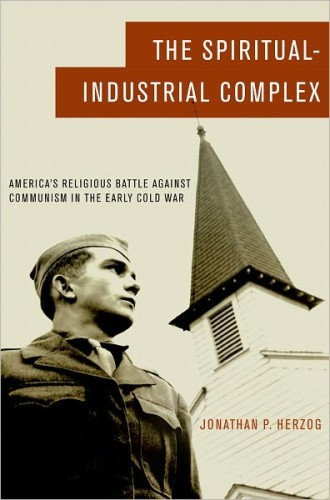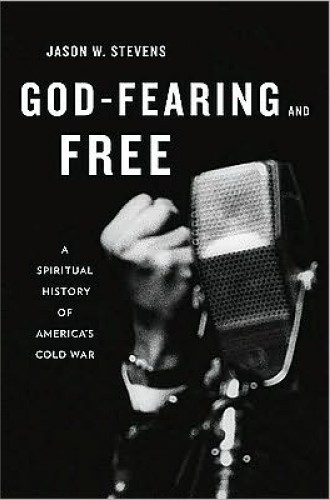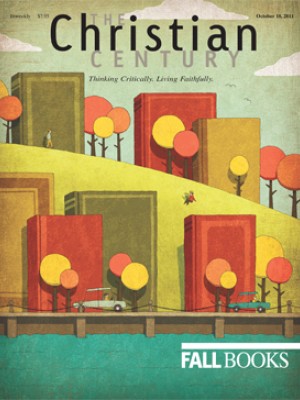The Spiritual-Industrial Complex and God-Fearing and Free
For those of us who spent our grammar school days diving beneath school desks in the civil defense drills of the 1950s, the link between faith and the cold war was pretty obvious. We had to keep the communists at bay at any cost, and although it was never clear to me how a school desk would protect me against a Soviet attack, I understood full well that our family's contribution to the effort was crucial. We needed to maintain a fully stocked larder, recite the Pledge of Allegiance (including the newly inserted words "under God") at school every day, never—never!—eat snow and, most important, attend church every Sunday.
The stakes could not have been higher. Nothing less than the survival of the free world hung in the balance. God was counting on us in the titanic struggle against godless communism.
And we Americans, God's favorite people, did not disappoint. As Jonathan P. Herzog demonstrates in The Spiritual-Industrial Complex, the years following World War II witnessed a surge in both nationalism and religiosity: "Millions of Americans, from presidents on down, participated in a spiritual crusade—not with bullets or bayonets but with patriotic affirmations."
Read our latest issue or browse back issues.
What set this crusade apart from previous religious awakenings, according to Herzog, was that the cold war revival was no grassroots affair. Instead, this surge of patriotic and religious piety, beginning under Harry Truman and intensified by Dwight Eisenhower, was orchestrated as carefully as D-Day or any of Eisenhower's military campaigns. Principals ranged from attorneys general and the director of the Federal Bureau of Investigation to presidents, members of Congress, the publisher of Time magazine and Whittaker Chambers, whose best-selling book Witness, an account of his conversion from communism to Christianity, asserted the utter incompatibility of the two. "The religious could not be Communists," Herzog writes, "but even more important, the irreligious could not be true Americans." By 1949, only one in ten Americans believed that someone could be both a communist and a Christian.
Clergy and other religious leaders were complicit in this conflation of piety and patriotism. Norman Vincent Peale and Billy Graham lent their credibility and their considerable constituencies to the effort. Fulton Sheen "became the era's preeminent Communist converter," thereby cementing the Roman Catholic Church's Americanness, which had been suspect only a world war earlier. The Knights of Columbus led the charge to add "under God" to the Pledge of Allegiance. Richard Nixon weighed in by declaring that the "greatest service that can be rendered in public life today is to help in the revitalization and rebuilding of spiritual and moral strength in America."
The engines of government shifted into high gear. Prayers were prescribed for public school classrooms. At Fort Knox, Kentucky, Brigadier General John M. Devine required his recruits to attend religious services; those who objected to such coercion had to meet individually with a chaplain for one hour. The air force provided a B-25 with full crew to transport a representative from the Moody Institute of Science from base to base to evangelize the force and, not incidentally, refute Darwinism. The State Department stocked "information centers" around the world—places where foreigners could obtain reading materials about the United States—with Bibles and religious periodicals like Commentary, Commonweal and the Christian Century. Truman created the Psychological Strategy Board in 1951. "The overall objective in seeking the use of religion as a cold war instrumentality should be the furtherance of world spiritual health," the board declared, "for the Communist threat could not exist in a spiritually healthy world."
Perhaps the most impressive mobilization was an initiative called Religion in American Life (RIAL). Fueled by corporate contributions, RIAL began with a series of advertisements, produced by the J. Walter Thompson Agency, featuring such celebrity endorsers as Norman Rockwell, Jackie Robinson, J. Edgar Hoover and even the fictional Betty Crocker, all discussing the importance of religion. Truman kicked off the campaign with a live address. "Each of us can do his part by a renewed devotion to his religion," the president said. "If there is any danger to the religious life of our nation, it lies in our taking our religious heritage too much for granted." The RIAL campaign, which its head, General Electric president Charles E. Wilson, characterized as "spiritual rearmament," ran for the decade from 1949 to 1958.
Citizens responded. From 1951 to 1961, religious groups in the United States increased their membership by 31 percent. Twenty-five million Americans donated a dollar each to sign a traveling "Freedom Scroll," thereby making the following affirmation: "I believe in the sacredness and dignity of the individual. I believe that all men derive the right to freedom equally from God. I pledge to resist aggression and tyranny wherever they appear on earth." The Fraternal Order of Eagles installed the Decalogue in public buildings and city parks, and the Los Angeles chapter of the Kiwanis Club printed and distributed 20,000 booklets warning against the spiritual perils of communism.
Herzog's very impressive historical research finds a decidedly more high-brow complement in God-Fearing and Free: A Spiritual History of America's Cold War, by Jason W. Stevens. The two authors plow some of the same furrows, notably the contributions of Graham and Chambers, but Stevens is far more ambitious. His sources range widely, from James Baldwin to Norman Mailer, and he sees both Graham and Reinhold Niebuhr as antimodernist critics in the cold war era, one from a conservative perspective and the latter from within the ranks of liberalism. Despite their differences, according to Stevens, "each was nevertheless broadly supportive of the Cold War consensus regarding the roles of American power and national interest."
Echoing Andrew S. Finstuen's Original Sin and Everyday Protestants: The Theology of Reinhold Niebuhr, Billy Graham, and Paul Tillich in an Age of Anxiety, Stevens argues that Graham and Niebuhr both reminded Americans of the doctrine of original sin. "In the shadow of concerns about the spread of totalitarian systems," he writes, "original sin was refurbished and then mobilized in a variety of cultural discourses that aimed to shore up democratic society against threats preying on the nation's internal weaknesses." With this move, Stevens argues, "Protestant theological countermodernism, and with it the theme of ending innocence about human nature and progress, was recodified and deployed in the Cold War to justify America's emergence as a superpower among Western nations and to instruct American citizens in their new role as defenders of freedom against totalitarian Communism."
In Herzog's account, the demise of the spiritual-industrial complex is just as intriguing as its origins. By the time Nixon and Nikita Khrushchev squared off in their infamous Kitchen Debate in 1959, Americans were seeking to peddle appliances, not Bibles, to godless communists. A series of Supreme Court decisions in the early 1960s, notably Engel v. Vitale on prayer in school, prompted John Kennedy to remark that the removal of prayer from the schools afforded parents the opportunity to reinforce their children's religious development at home.
The most acrobatic pivot was performed by Tom C. Clark, Truman's attorney general, who was appointed to the Supreme Court in 1949. As attorney general, Clark conceived the idea of a "Freedom Train," a traveling exhibition of America's founding documents. In 1947, Clark electrified the annual convention of the International Sunday School Association, meeting in Des Moines, Iowa, with his summons to piety in the national interest. "Never in the annals of time has the matter been reduced to such terrifying simplicity," he said. "It is a choice between God and Mammon." Clark concluded: "Let us build for the future on the rock of religion."
Sixteen years later, writing the majority opinion in Abington v. Schempp, a follow-up case on school prayer, Clark said that the state should give religion a wide berth. "We have come to recognize through bitter experience," he wrote, "that it is not within the power of government to invade that citadel, whether its purpose of effect be to aid or oppose, to advance or retard."
Although Herzog doesn't explore the reasons behind Clark's change of heart, the language of his opinion serves as a useful reminder about the dangers of conflating church and state, patriotism and piety. Does anyone seriously believe that the cause of religion was advanced by having "In God We Trust" emblazoned on our currency or shoehorning "under God" into the Pledge of Allegiance? Few would argue that the credibility of the state was harmed by this collusion of theology and nationalism. The integrity of the faith, however, is another matter.
In retrospect, it's not entirely fair to criticize religious leaders for their complicity in providing a theological gloss for America's cold war agenda. The rewards, at least in the short term—cultural relevance together with increased attendance, membership and giving—were palpable. And best of all, the costs were deferred, amortized over the Vietnam War, the counterculture and the ascendance of the religious right. Tragically, despite its immediate returns, American religious leaders' bargain of the 1950s turned out to be a Faustian one.







